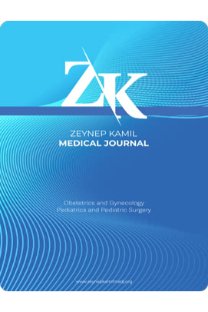Pediatrik tıkayıcı uyku apnesi sendromu ve habituel horlamanın ayrımında orofarengeal muayene bulgularının tanısal değeri
Diagnostic value of oropharyngeal examination findings in differentiating pediatric obstructive sleep apnea syndrome from habitual snoring
Sleep Apnea, Obstructive, Snoring, Child, Diagnosis, Differential,
___
- 1.S, Tishler PV, Schluchter M, Aylor J, Clark K, Graham G. Risk factors for sleep-disordered breathing in children. Associations with obesity race, and respiratory problems. Am J Respir Crit Care Med 1999; 159:1527-1532
- 2.Gislason T, Benediktsdottir B. Snoring, apneic episodes, and nocturnal hypoxemia among children 6 months to 6 years old. An epidemiologic study of lower limit of prevalence. Chest 1995;107:963-966
- 3.Caroll JL, McColley SA, Marcus CL, Curtis S, Loughlin GM. Inability of clinical history to distinguish primary snoring from18.obstructive sleep apne syndrome in children. Chest 1995; 108:610-618
- 4.Saeed MM, Keens TG, Stabile MW, Bolokowicz J, Ward SLD. Should children with suspected obstructive sleep apnea syndrome and normal nap sleep studies have overnight sleep studies ? Chest 2000; 118:360-365. 5.Sivan Y, Kornecki A, Schonfeld T. Screening obstructive sleep apnea syndrome by home videotape recording in children. Eur Resp J 1996; 9:2127-2131
- 6.Brunetti L, Rana S, Lospalluti ML, Pietrafesa A, Francavilla R, Fanelli M, et al. Prevalence of obstructive sleep apnea syndrome in a cohort of 1,207 children of southern Italy. Chest 2001;120:1930-1935
- 7.Friedman M, Tanyeri H, Rosa ML, Landsberg R, Vaidyanathan K, Pieri S, et al. Clinical predictors of obstructive sleep apnea. Laryngoscope 1999; 109:1901-1907
- 8.Walker RP. Snoring and obstructive sleep apnea
- In: Bailey JB, Calhoun KH and Deskin RW, eds
- Head & Neck Surgery-Otolaryngology. 2nd ed
- Philadelphia: Upincott-Raven Press, 1988: 707-729
- 9.Brodsky L, Moore L, Stanievich JF A comparison oftonsillar size and oropharyngeal dimensions in children with obstructive adenotonsillar hypertrophy. Int J Pediatr Otorhinolaryngol 1987; 13:149-156
- 10.Greenfeld M, Tauman R, DeRowe A, Sivan Y Obstructive sleep apnea syndrome due to adenotonsillar hypertrophy in infants. Int J Pediatr Otorhinolaryngol 2003; 67:1055-1060
- 11.Leach J, Olson J, Hermann J, Manning S
- Polysomnographic and clinical findings in children with obstructive sleep apnea. Arch Otolaryngol Head Neck Surg 1992; 118:741-744
- 12.Arens R, McDonough JM, Costarino AT, Mahboubi S, Tayag-kier CE, Maislin G. Magnetic resonance imaging of the upper airway structure of children with obstructive sleep apnea syndrome
- Am J Respiar Crit Care Med 2001; 164:698-703
- 13.Brooks Lf, Stephens BM, Bacevice AM. Adenoid size is related to severity but not the number of episodes of obstructive apnea in children. J Pediatr 1998; 132:682-686
- 14.Mahboubi S, Marsh RR, Potsic WP, Pasquariello PS. The lateral neck radiograph in adenotonsillar hyperplasia. Int J Pediatr Otorhinolaryngol 1985; 10:67-73
- 15.Guilleminault C, Khramtsov A. Upper airway resistance syndrome in children: a clinical review
- Semin Pediatr Neurol 2001; 8:207-15
- 16.Guilleminault C, Quo SD. Sleep-disordered breathing. A view at the beginning of the new Millennium. Dent Clin North Am 2001; 45:643-56
- 17.Marcus CL. Pathophysiology of childhood obstructive sleep apnea: current concepts. Respir Physiol 2000; 119:143-54
- 18.Section on Pediatric Pulmonology, Subcommittee on Obstructive Sleep Apnea Syndrome. American Academy of Pediatrics. Clinical practice guideline: diagnosis and management of childhood obstructive sleep apnea syndrome. Pediatrics 2002; 109:704-12
- 19.Fregosi RF, Quan SF, Kaemingk KL, Morgan WJ, Goodwin JL, Cabrera R, et al. Sleep-disordered breathing, pharyngeal size and soft tissue anatomy in children. J Appl Physiol 2003; 95:2030-8
- 20.Laurikainen E, Erkinjuntti M, Alihanka J, Rikalainen H, SuonpaaJ. Radiological parameters of the bony nasopharynx and adenotonsillary size compared with sleep apnea episodes in children
- Int J Pediatr Otorhinolaryngol 1987; 12:303-310
- ISSN: 1300-7971
- Yayın Aralığı: 4
- Başlangıç: 1969
- Yayıncı: Ali Cangül
Ayhan SÖĞÜT, LOKMAN UZUN, Remzi ALTIN, MEHMET BİROL UĞUR
Report of two cases: Voluminous paraovarian cysts
Karageyim A. Yasemin KARŞIDAĞ, Bülent KARS, Ramazan DANSUK, Orhan ÜNAL, M. Cem TURAN, Dilek YAVUZER
Şihmir ŞİMŞEK, Mustafa BÜYÜKAVCI, M. Dursun KAYA, Recep AKDAĞ, Cahit KARAKELLEOĞLU
19. gebelik haftasında saptanan tek taraflı alt ekstremite anomalisi
Levent TÜTÜNCÜ, Murat MUHCU, Ercüment MÜNGEN, Yusuf Ziya YERGÖK
İSMAİL ÖZDEMİR, Taner YAVUZ, Özlem YAVUZ, Furat DEMİRCİ, Aslı SOMUNKIRAN
Endometrial intraepitelyal karsinomun eşlik ettiği uterin seröz papiller karsinom
Gözde KIR, Handan ÇETİNER, Sadiye EREN, Ayşe GÜRBÜZ
Memenin apokrin karsinomu (bir olgu sunumu)
Hallaç Sevinç KESER, Nimet KARADAY, Medine MURTAZAOĞLU, Aylin Ege GÜL, Özdemir Nagehan BARIŞIK, Cumhur Selçuk TOPAL
Çocukluk çağı akut immun trombositopeni olgularında farklı tedavi protokollerinin değerlendirilmesi
Meral İNALHAN, BELTİNGE DEMİRCİOĞLU KILIÇ, Müjgan ORAL, Serpil DEĞİRMENCİ, Arslan Özlem ÜNLÜTÜRK, Özlem TEMEL, Savaş İNAN
Agresif anjiomiksoma: Olgu sunumu
Aylin Ege GÜL, Serap KOÇ, Sibel ŞENSU, Hallaç Sevinç KESER, Oluş APİ, Nimet KARADAYI
Postomenopozal sürenin lipid ve lipoprotein seviyeleri üzerindeki etkisi
KORAY ELTER, Elif Esra UYAR, Hüsnü GÖKASLAN, Zehra Neşe KAVAK
